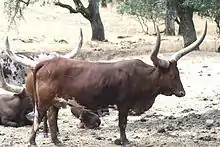Sanga cattle
Sanga cattle is the collective name for indigenous cattle of sub-Saharan Africa. They are sometimes identified as a subspecies with the scientific name Bos taurus africanus.[1] These cattle originated in East Africa, probably the western shores of Lake Victoria, and have spread down the river Nile (i.e. northwards), with depictions on Ancient Egyptian murals. Sanga are an intermediate type, probably formed by hybridizing the indigenous humpless cattle with Zebu cattle.[2] However, archaeological evidence indicates this cattle type was domesticated independently in Africa, and bloodlines of taurine and zebu cattle were introduced only within the last few hundred years.[3] The timeline for their history is the subject of extensive debate. A combination of genetic studies with archaeological research, including cultural history, has clarified the question of the complex origin of African cattle in recent years. Thus African cattle descend firstly from an Aurochs domesticated in the Near East. After their introduction to Egypt, about eight thousand years ago, they spread all over the Sahara which was then still green, up to West Africa. The north African pastoralists interbred their domestic cattle with wild African Aurochs of various regional races, both in the paternal and maternal lines over a long time, which is reflected in the genetic distinctness of African cattle from both European / near Eastern and from Indian Zebu cattle.[4] Hereby special adaptations to the African climate and conditions were introduced, that characterise African cattle - both those deriving solely from Aurochs and the Sanga cattle with their Zebu admixture. Morphological features of early African cattle, such as lyre-shaped horns, are depicted on murals of Ancient Egypt. Some authors date the first Sanga cattle, which originated through by crossing in of Zebu bulls in northeast and east Africa, from 1600 BC on.[5] They are distinguished by having small cervicothoracic humps, that are typical for (wild) Aurochs,[6][7] instead of the high thoracic humps which characterize the Zebu.


Breeds of Sanga cattle
Pure Sanga cattle
- Abigar
- Afrikaner
- Ankole (Original African type)
- Drakensberger cattle
- Kuri cattle
- N'Dama
- Nguni
- Red Fulani
- Tuli
- Tswana
- White Fulani cattle
Crossed Sanga cattle
- Ankole-Watusi (Modern American breed) developed by crossing in of European cattle.
- Bonsmara (A breed developed in the 1940s in South Africa by using five-eighths Afrikaner or 62,5% African Bos Taurus)
- Boran cattle (12% African Bos Taurus)
Trypanotolerance in Sanga cattle
Trypanosomiasis poses a considerable constraint on livestock agricultural development in Tsetse fly infested areas of sub Saharan Africa, especially in west and central Africa. International research conducted by ILRI in Nigeria, the Democratic Republic of the Congo and Kenya has shown that the N'Dama is the most resistant breed.[8][9] In Nigeria, research has shown that N'Dama is up to 2-3x (or 25%) more resistant than Nguni cattle. And F1 N'Dama x Nguni 16.5% better than pure Nguni.[10] While in Kenya research conducted by KALRO has shown a similarity with crossbreeding N'Dama x Boran cattle.[11][12][13]
References
- Relationships between production and product traits in subpopulations of Bonsmara and Nguni cattle P.E. Strydom1, R.T. Naudé, M.F. Smith, A. Kotzé, M.M. Scholtz and J.B. van Wyk, South African Journal of Animal Science 2001, 31(3)
- Mukasa-Mugerwa, E. (1989). "A review of reproductive performance of female Bos Indicus (Zebu) cattle". International Livestock Research Institute. Retrieved 2010-03-02.
- Caroline Grigson: An African origin for African cattle? — some archaeological evidence. African Archaeological Review 1991, Volume 9, Issue 1, pp 119-144
- Pitt, Daniel, Natalia Sevane, Ezequiel L. Nicolazzi, David E. MacHugh, Stephen D. E. Park, Licia Colli, Rodrigo Martinez, Michael W. Bruford, Pablo Orozco‐ter Wengel, “Domestication of cattle: Two or three events?”, in: Evolutionary Applications – Special edition, 28th June, 2018 published by John Wiley & Sons Ltd. https://doi.org/10.1111/eva.12674
- References Payne, 1964 and Schoeman, 1989 in Relationships between production and product traits in subpopulations of Bonsmara and Nguni cattle P.E. Strydom1, R.T. Naudé, M.F. Smith, A. Kotzé, M.M. Scholtz and J.B. van Wyk, South African Journal of Animal Science 2001, 31(3)
- Foidl, Daniel, "Aurochs cow colour schemes",in: The Breeding-back Blog, (22nd March, 2020). http://breedingback.blogspot.com/
- cf. Foidl, Daniel [illustration of Auerochs] in: Garrick, Dorian J and Anatoly Ruvinsky (eds.), The Genetics of Cattle, (2nd ed.), Boston, 2015: CAB Int., p. 624
- http://www.fao.org/3/y5832e/y5832e05.htm
- https://www.slideshare.net/mobile/ILRI/animal-genetic-resources-characterization-and-conservation-research-in-africa-an-overview
- http://www.fao.org/Wairdocs/ILRI/x5443E/
- https://www.researchgate.net/figure/F2-generation-of-NDama-x-Boran-cross_fig1_256631840/amp
- Orenge, C. O.; Munga, L.; Kimwele, C. N.; Kemp, S.; Korol, A.; Gibson, J. P.; Hanotte, O.; Soller, M. (2012). "Trypanotolerance in N'Dama x Boran crosses under natural trypanosome challenge: Effect of test-year environment, gender, and breed composition". BMC Genetics. 13: 87. doi:10.1186/1471-2156-13-87. PMC 3519672. PMID 23075408.
- https://www.ilri.org/publications/population-parameters-traits-defining-trypanotolerance-f2-cross-ndama-and-boran-cattle